Hints and Teasers
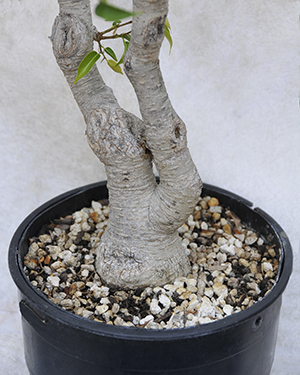
Helpful Hints 3
by Lew Buller
Use Brass not iron or steel, Testing for moisture, Making your own tools, Soil additives, Jin as a major design feature, Keep your tools clean and sanitary
In making tanuki, scions are sometimes fastened in place with small nails. The nails should be brass as it does not rust and discolor the same way as iron. This also applies to the use of screws. I like unusually shaped bonsai and so I fastened two trunks together using a brass screw. The cambium will heal over the opening I drilled for the screw and the two trunks should begin to self-graft as there is no possibility of movement away from one another.
The recommendation has been made that driving a nail into the trunk will provide iron to a tree showing signs of iron deficiency. Doesn’t work. Initial symptoms of iron deficiency are yellowing between leaf veins and browning at the edges of leaves. Chelated iron is immediately available to plants and can reverse leaf yellowing.
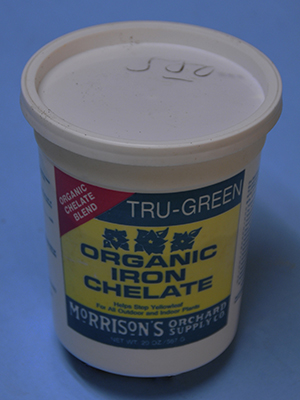
The tree will take up only chelated iron in which chemical agents have been added to prevent iron from precipitating out of solution. If you have acid-loving plants and/or live in an area where the water has a high pH, you should do a bit of research on the Internet for more information.
Testing for moisture
My moisture meter is erratic and my educated thumb will reach only so far down into the soil. Leave a bamboo chopstick overnight in deep soil and check it the next morning. Any moisture in the soil will dampen the chopstick and tell you whether your soil is moist.
Making your own tools
Warren Hill was Curator of the Bonsai Collection at the National Arboretum when I volunteered to work a week there. He had an interesting tool I have not been able to find elsewhere. It was a 6-inch piece of copper pipe with teeth on one end that could be used to extract cores from old soil around bonsai. The holes could then be filled with fresh soil and the plant would be healthier.
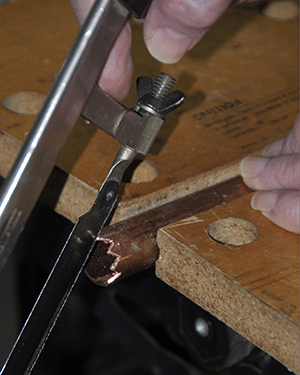
Having worked my way through college as a jackleg block layer, electrician, and carpenter, I learned my way around tools. I traded our plumber some popcorn for his kids for some scrap copper pipe. The pipe was hardened and could be worked. Here’s my attempt to make the kind of tool Warren had. In theory, it looks good.
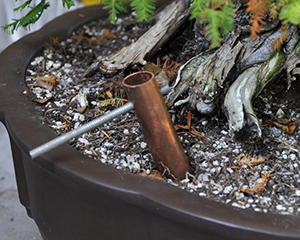
Here are the results. The reamer is about 2 ½” into the soil, not quite at the bottom of the pot. In my first try, I hit something about 1” down–a large root. To avoid damage, I moved to a different location. The tan leaves tell you something is wrong with the roots–the tree needs to be transplanted. January, not now in hot August, is the time for transplanting. In addition to holes made with the reamer, I will trench around the inside of the pot and add fresh soil. Then do a complete transplant the following January.
Soil additives
Some nutrients are more effective if they are added to the soil mix. That way, they are right at the roots. Here are things I sometimes add along with the reasons for adding them.

1. Cottonseed meal in the mix distributes the meal throughout the soil, whereas cakes deliver nutrients only to the roots directly under the cake; Water carrying nutrients does not flow sideways, but rather directly down. Experiment to find the amount that works best in your soil.
2. Gypsum is calcium sulfate and I use it because of the high 8.2 pH of San Diego water. The sulfate acidifies the soil (lowers the pH) and the calcium ions displace sodium ions.
3. Ironite not only provides iron, but also is a very mild fertilizer with NPK numbers of 1-0-1. Some of the micro-nutrients plants need are available as well..The label says Ironite includes calcium, sulfur, boron, iron, manganese, molybdenum, and zinc as well as nitrogen and potassium.
4. Blood meal has an NPK number of 12-0-0. It is an organic source of nitrogen, therefore slow to be absorbed by plants. I use it with discretion; it doesn’t go in every soil mix, but only the ones where I want substantial green growth. For a while, I added fir bark to my soil mix, and this requires extra nitrogen as the wood seems to have first priority on any nitrogen in the soil.
5. Bone meal is very slow to break down and release phosphorus, taking at least three years. Since I transplanted every two years in the past, I didn’t use bone meal much but rather relied on commercial fertilizers for phosphate. Had I known that some of my plants would go as long as 5 years without transplanting, I would have been using bone meal.
Jin as a major design feature
San Diego residents have long used Japanese boxwood as a landscape plant. Unfortunately for bonsai lovers, boxwood grow straight as a stick. Eitan (the Apprentice) has a job that takes him over quite a bit of San Diego County and he often sees plants that are out of place and finds owners willing to give them to him. Many times one of the trunks or branches are long dead and don’t look good. What to do? Decide whether to feature the dead wood or the live foliage and develop the plant accordingly.
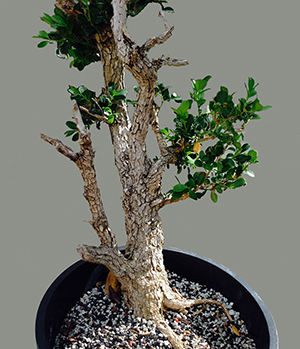
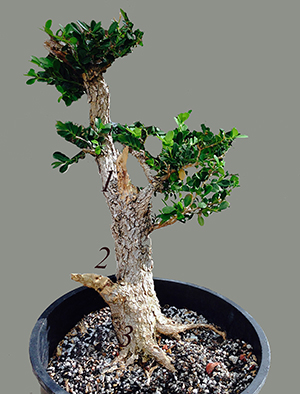
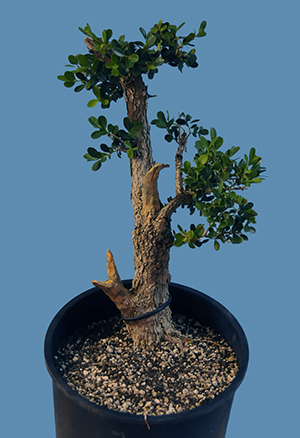
Eitan decided to feature the foliage and to reduce the dead wood to jin. I made a first pass in a way that didn’t affect the tree. A little time on the computer with Photoshop and we had a basis for discussing the actual changes. Two locations lent themselves to jin ( 1 and 2) and the third to shari (3).
The potential shari partially hidden behind the trunk turned out to be a stone providing support to the back of the tree. We disposed of that issue by putting a wine bottle cork in its place and wiring the tree tightly against the cork. The copper wire inside the drip irrigation tubing was taken though the side of the pot and tied off tightly outside.
Starting with the jin marked 2, we redesigned the jin to keep it from directing the viewer’s eye away from the trunk and left a small vertical jin. At 1, we created a jin pointing away from the viewer. Both jins received 2 coats of lime sulfur–2 coats because the wood is very hard and does not take up the lime sulfur quickly. Finally we added soil to cover roots in front and get the plant used to growing in a new attitude. The roots will be shown in the final potting.
Be meticulous in keeping your tools clean and sanitary and your trees free of disease
My arborist friend and I got a question when we did some tree trimming for the owner of a wine-producing vineyard. She wanted to know if we sterilized our tools; the people working in her vineyard were required to. Our sterilizing usually consisted of wiping the blades on our pants, but we occasionally used Lysol. We told her Lysol, and it satisfied her. Unbeknownst to us, Lysol is one of the recommended treatments for sterilizing tools. Do some research on the Internet and see for yourself.
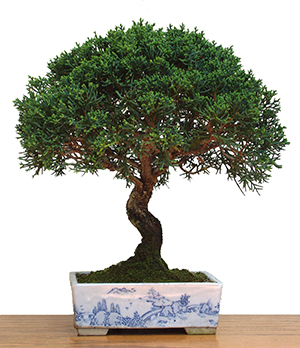
With the prohibition of a number of fungicides, it has become harder to keep trees free of disease. One of my favorites is a small grafted Kishu that looked like this in May 2007. Jump forward to August 2014 to see what has happened in the current year. Before you look, I will tell you that I have tried soil drenches, hydrogen peroxide, and the only available fungicide I can find and it continues to go steadily downhill. Whatever disease it has spread to many of my other grafted Kishu and is killing them, too. Only the Kishu; my other junipers were left untouched. Had I known then what I know now, I would have thrown away the first tree that showed any symptoms.
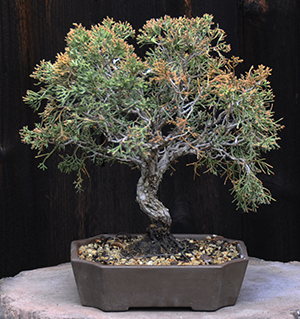
I am going to make a last ditch effort and order a fungicide I have used successfully in the past. Wish me luck.
